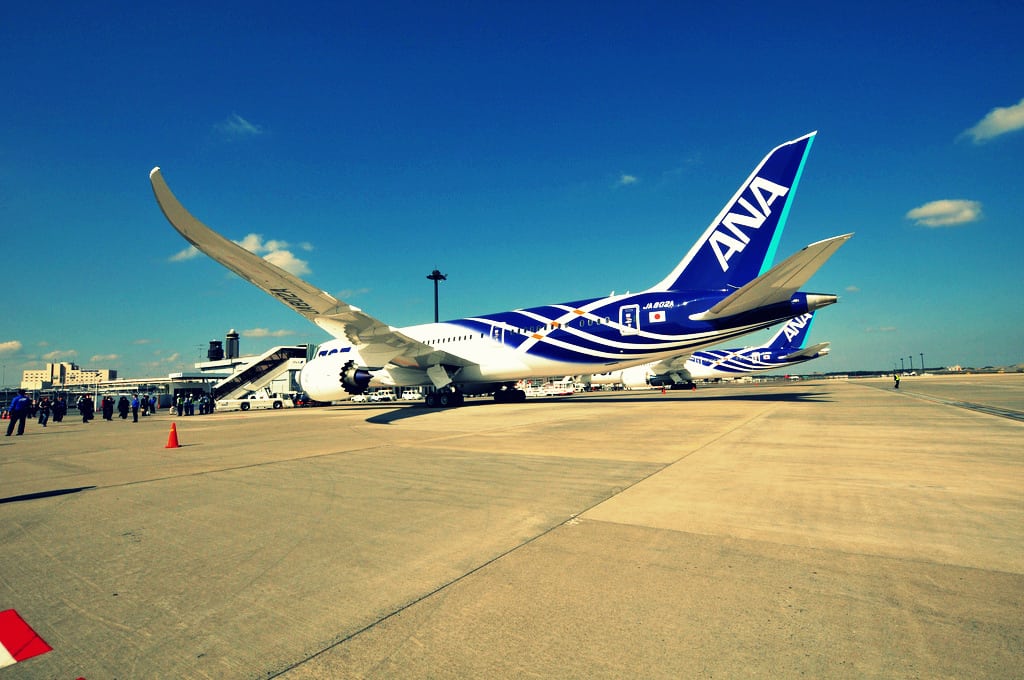Skift Take
The much-lobbied-for and awaited inaugural San Jose to Tokyo's Narita took off the same day that FAA announced more investigation into Boeing Dreamliner's safety.
By the time the All Nippon Airways Dreamliner 787 touched down at Narita International Airport late Saturday afternoon — some 11 hours after leaving San Jose — it was clear to most on board the sold-out inaugural flight just why airlines around the world remain committed to the newest aircraft from Boeing despite a string of glitches.
For one thing, the plane flies on 20 percent less fuel than other jetliners, allowing airlines like ANA to begin service to mid-size airports like Mineta San Jose International. And for another, the experience of traveling on the Dreamliner is visceral. Throughout the trip passengers snapped photos of the aircraft. And one, wearing a Dreamliner T-shirt, raced around taking video of every corner of the plane.
Midway into the flight — about 5 p.m. San Jose time — the aircraft’s windows, which are significantly larger than those on other jetliners, began to glow with a soft green-blue color. The electronic-shades allow passengers to change the tint of windows with the push of a button, creating an effect similar to sunglasses. Even the toilets are technologically advanced: they close and flush with a wave of a hand.
The engines are quieter. The blue-hued ceilings are higher than anyone can reach. Indeed, the most striking aspect about the aircraft is the spacious feeling.
“It seemed like the NBA designed this,” said Silicon Valley Leadership Group CEO Carl Guardino, who played an instrumental
role in bringing the new route to San Jose and was part of a delegation of San Jose officials on the flight.
Seasoned travelers noted that the 787’s increased cabin pressure and higher humidity made the flight less wearing on their bodies. And the plane provides a quieter, less bouncy ride. Passengers don’t have to raise their voices to be heard over the roar of engines.
Still, the flight across the Pacific hit pockets of turbulence — and its highly anticipated San Jose departure on Friday occurred on the day the FAA announced it would launch a “review” of recent problems afflicting the 787, including an electrical fire on a Japan Airlines Dreamliner in Boston earlier this week. But the maiden voyage at 40,000 feet was as uneventful as a trip to the library, though a lot more fun.
The experience of floating some 5,500 miles across the ocean on the industry’s most technologically sophisticated aircraft calmed the nerves even of anxious air travelers.
“The boarding was smooth, the takeoff was smooth — the (new San Jose) airport lounge was beautiful and relaxing,” said Patrick Bray, a technology consultant who makes regular trips to Asia from the Bay Area but nonetheless experiences a knot of anxiety in his stomach before every departure.
“These things eased my anxiety,” he said.
And ANA’s reputation for great service was on display: flight attendants were constantly in motion, bringing food and drinks to passengers. The galley in the back of the plane is something of a mid-flight gathering place for restless travelers, who can sip drinks, from vodka to apple juice, or nibble on light snacks.
“The service is like, ‘What-else-can-I-do-for-you?'” said Marc Casto, president of San Jose-based Casto Travel, which handles corporate travel accounts for many Silicon Valley companies.
Some passengers boarded flight NH 1075 to experience first-hand a small piece of aviation history: San Jose International is the first Bay Area airport to have a scheduled Dreamliner flight. Others came along because of ANA’s reputation for exacting service — and patience with small children. And there were travelers simply happy to grab a cross-Pacific flight that originated out of their home airport.
“It’s very convenient for those of us who live in the San Jose area,” Mimi Suwa, a Los Gatos resident, said after waking from a comfortable nap five hours into the flight. She travels to Japan two to three times a year to visit family.
Being able to leave home at 10 a.m. for a 11:45 a.m. international flight made all the difference, she said. compared to the times she flies out of San Francisco International. “On Highway 101, the traffic is so busy and thick,” Suwa said. “This was great.”
Friday’s flight was the beginning of ANA’s five-day-a-week route between San Jose and Tokyo, which the airline expects to expand to a daily service in coming months. San Jose officials hope it will lead to more international departures from the city’s airport, which received a major makeover a few years ago just as the U.S. airline industry went into a financial nose-dive, leading to carrier consolidations and dramatic reductions in service.
For San Jose and ANA, the flight was much more than bubbly drinks and an attentive crew. Officials, from city hall to the corporate world, have committed to doing all they can to ensure the success of the new service, which ANA took a significant risk to launch. If the route is a success, the airport could land additional routes to such cities such as Shanghai, Seoul, Frankfurt and London, as well as a host of East Coast cities, they say.
“There is a tendency in the industry to always play catch-up,” Casto said. “I strongly believe others will follow suit.”
The flight, which began with a crisp bow from flight attendants and a soft rumble of the engines, ended with a gentle touchdown on the other side of the globe. And the plane with some 158 passengers pulled up to its gate early.
Contact John Boudreau at 408-278-3496; follow him at Twitter.com/svwriter ___
![]()
The Daily Newsletter
Our daily coverage of the global travel industry. Written by editors and analysts from across Skift’s brands.
Have a confidential tip for Skift? Get in touch
Tags: ana, dreamliner, nrt, sjc
Photo credit: ANA 787DreamLiner at Tokyo's Narita International Airport. Pyonkyo Omeyama / Flickr.com
